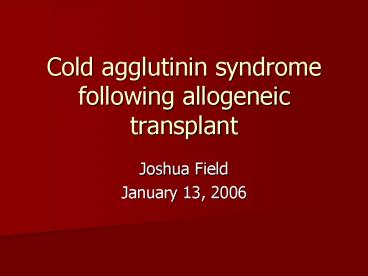Cold agglutinin syndrome following allogeneic transplant - PowerPoint PPT Presentation
1 / 28
Title:
Cold agglutinin syndrome following allogeneic transplant
Description:
... man with a history of chronic lymphocytic leukemia (CLL). Diagnosed in 1993. ... Symptoms and signs: Key is the thermal amplitude. Acrocyanosis. Hemoglobinuria ... – PowerPoint PPT presentation
Number of Views:148
Avg rating:3.0/5.0
Title: Cold agglutinin syndrome following allogeneic transplant
1
Cold agglutinin syndrome following allogeneic
transplant
- Joshua Field
- January 13, 2006
2
Case
- 57 year-old man with a history of chronic
lymphocytic leukemia (CLL). - Diagnosed in 1993.
- Lymphocytosis and adenopathy.
- Treated with ProMACE-CytaBOM Procarbazine,
mechlorethamine, adriamycin, cyclophosphamide,
etoposide, cytarabine, leuvorin, methotrexate. - Achieved a remission.
3
Case
- Relapsed 1997.
- Thereafter
- Chlorambucil
- CVP
- Fludarabine
- Rituximab
- Cyclophosphamide, fludarabine, rituximab
- Referred for an allogeneic transplant.
- Workup allogeneic transplant
- ZAP70
- cytogenetics 48 XY, trisomy 12, 19 in 5
metaphases, deletion 7 in 1 metaphase.
4
Case
- 8/19/05 Day 0 Fludarabine, busulfan,
thymoglobulin 6/6 matched sibling transplant. - Reduced conditioning regimen
- Previous therapy
- Graft versus tumor effect
- OPos into OPos
- Course complicated by fevers with thymoglobulin.
- Discharged on 8/30/05 on FK-506.
5
Case
- 9/4/05 Day 17 presented with malaise and
fevers. - 2-3 day history of fatigue.
- Poor PO intake.
- Low-grade fevers 100.8.
- Admitted to 5900 and bloodwork sent.
6
Case
MCV 100.6
9.8
100
136
35
38
76
0.8
5.0
25
T. bilirubin 1.8
PT 14.3
AST 315
INR 1.06
ALT 255
PTT 31
LDH 1981
7
Washed, Warmed
8
Case
9
(No Transcript)
10
Hospital Admission
11
Case
- Additional labs
- Reticulocyte 2.5
- Haptoglobin lt7
12
Peripheral smear
13
Autologous Cells
14
(No Transcript)
15
(No Transcript)
16
Cold agglutinin syndrome
- Less common than WAIMA.
- Average age 66.
- Symptoms and signs
- Key is the thermal amplitude.
- Acrocyanosis
- Hemoglobinuria
- Anemia pallor, fatigue, dyspnea, weakness.
- Splenomegaly.
17
Cold agglutinin syndrome
- Idiopathic
- Secondary
- Non-malignant
- Mycoplasma
- EBV
- Malignant lymphoproliferative disorders.
- Post-transplant?
18
Cold agglutinin syndrome
- Laboratory findings
- Autoagglutination intense at 4C, reversible at
37C. - DAT IgG-C3 (100).
- Smear agglutinated red cells, less spherocytes,
polychromasia. - Hemolysis
- IgM target I, i, Pr
- Course typically chronic, mild to moderate
anemia (Hgb 9-12 g/dL).
19
(No Transcript)
20
Treatment
- Avoid cold
- Steroids not terribly effective
- Immunosuppression
- Chlorambucil 2-4 mg/day
- Rituximab
- Fludarabine
- Plasma exchange
- Cumbersome warm room, blood, inpatient.
- Effects short-term
- Splenectomy ineffective
- CLL
- 5
- Treat the CLL.
21
Post-transplant hemolysis
- ABO
- Minor incompatibility O?A
- Passenger lymphocyte syndrome day 10
- Major incompatibility A?O
- Microangiopathy
- TTP
- DIC
- Autoimmune hemolysis
- CAIHA
- WAIHA
22
Minor incompatibility
- Manipulation of product plasma reduce lt 300 cc
(less if titers gt 256) - Check isohemagglutinin titers of donor.
- Antibodies produced by lymphocytes in infused
product - DAT positive 4-18 days post transplant.
- Typically
- IgG mediated
- Direct to ABO
- Anti-A or B titers pre-transplant do not predict
hemolysis (Hows, et al. Blood, 1986). - Treatment
- Supportive
- Severe hemolysis consider plasma or red cell
exchange.
23
Major incompatibility
- Manipulation of product
- Red cell reduced lt 10 cc
- Check isohemagglutinin titers in recipient.
- Stussi, et al. Bone Marrow Transplantation, 2002.
- Delayed red cell engraftment (P0.0001)
- Pure red cell aplasia (6).
- No overall effect on survival, engraftment of
other cell lines or GVHD. - Worel, et al. Transplantation, 2000.
- Delayed red cell engraftment (32 days vs. 20
days) - Pure red cell aplasia (3)
- Treatment is plasma exchange.
24
Post-transplant autoimmune hemolysis
- Incidence following transplant 3 (Abou-Elella,
et al. Transfusion, 1995). - From where does the antibody arise? (Chen, et al.
Bone Marrow Transplantation, 1997) - Donor antibodies
- 2 groups of patients cold antibody (2-6 months
post-transplant), warm antibody (12-18 months
post-transplant) - Correlates to the production of IgM and IgG by
engrafted B cells. - T cell depletion
25
Case
- Diagnosed with cold agglutinin syndrome.
- Previously initiated on steroids due to presumed
GVHD. - Transfusion medicine consulted for consideration
of plasma exchange. - Performed 8 procedures while as an inpatient,
approximately qod. - 1.5 L all albumin exchange.
- Room heated to 90F.
- Received warmed PRBCs.
26
Case
- Treated with anti-CD52 monoclonal antibody
campath. - 5 doses daily SQ.
- Treated with rituximab anti-CD20 monoclonal
antibody. - Day 30 STR 87 donor 13 patient
- Day 100 STR gt95 donor
27
PEX
Day 0
Campath
Rituxan
28
(No Transcript)































